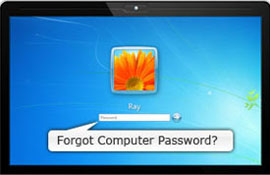Question: When I start up the computer, it asks the start up password? How to remove the Windows startup password? The OS is Windows XP.
Startup password? Is it the BIOS password or Windows login password? Does it ask for a password when you FIRST start it on, like before Windows loads or after?
If it appears before Windows loads, it should be the BIOS password. The BIOS is often used to describe a software that is programmed into a ROM, that runs every time you boot up a computer. And a BIOS password refers to a password set on the Bios or security chip. It appears before the operating system loads, usually on a black screen a few seconds after the laptop is started.
If so, you can simply remove the BIOS password as this will act to wipe clean all of the memory and settings in BIOS, including the stored password. Then put it back after 15-30 minutes and the data contained into the BIOS memory should be volatilized. If you are not good at computer, it’s not advised to do it by yourself. Instead, you can ask for help from a computer expert or your computer manufacture.
If the startup password appears after Windows loads, it should be your Windows login password. For this, you can simply log on to another user account with admin privileges with its password, and then reset the password for your target user account by using following steps.
1. Go to Start button and click Run box.
2. Enter “lusrmgr.msc” in the Run box and click OK.
3. Expand the Users folder on the coming Local Users and Groups window. You’ll see all the user accounts on the computer.
4. Right-click your target user account and select Reset password.
5. Enter a new password twice for the target account.
That’s all. Done! If you don’t have another admin account available on the logon screen, you can have a try of the default administrator account. It’s well known that the built-in administrator in Windows XP is enabled and not password protected by default. Press Ctrl+Alt+Del twice on the Windows logon screen to bring up the classic log-on box, type “administrator” in the username box and then press Enter to try to get into the administrator account. If you never set a password for this account, you’ll be able to get into Windows. Next you can follow the directions listed above to reset the lost Windows XP password. If failing to get into Windows, you can resort to other methods, like third-party Windows password reset applications.
Windows Password Breaker Professional is professionally designed to reset forgotten login passwords for Windows 7/Vista/XP and Window server 2008(R2)/2003(R3)/2000. With this powerful application, you can burn a bootable password reset disk with a CD/DVD or USB flash drive in seconds in any PC. Then you can boot the computer you want to reset password for from the bootable disk. After that, you’ll be able to reset the forgotten Windows password to blank in a minute.
The whole Windows password reset process will cost you a few minutes, no matter how long and complicated your lost password is. 100% secure guaranteed. No any data loss or damage. No computer skills required. Video Guide and step-by-step tutorial are available on its official website.
